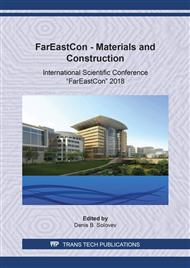[1]
On approval of energy efficiency requirements for buildings, structures, structures: Order of May 17. Ministry of Regional Development of the Russian Federation. Moscow. 224 (2011).
Google Scholar
[2]
Yatsenko, E.A., Goltsman, B.M., Smoliy, V.A., Kosarev, A.S., Bezuglov, R.V., Investigation of the Influence of Foaming Agents Type and Ratio on the Foaming and Reactionary Abilities of Foamed Slag Glass. Biosciences Biotechnology Research Asia. 12 (2015) 625-632.
DOI: 10.13005/bbra/2242
Google Scholar
[3]
Yatsenko, E.A., Goltsman, B.M., Smoliy, V.A., Kosarev, A.S. Investigation of a porous structure formation mechanism of a foamed slag glass based on the glycerol foaming mixture. Research Journal of Pharmaceutical, Biological and Chemical Sciences. 7 (5) (2016) 1073-1081.
Google Scholar
[4]
Yatsenko, E.A., Gol'tsman, B.M., Kosarev, A.S., Smolii, V.A., Yatsenko, L.A., Synthesis of Foamed Glass Based on Slag and a Glycerol Pore-Forming Mixture. Glass Physics and Chemistry. 44 (2) (2018) 152–155.
DOI: 10.1134/s1087659618020177
Google Scholar
[5]
Yatsenko, E.A., Kosarev, A.S., Karandashova, N.S., Goltsman, B.M., Smoliy, V.A., Technological Features of Production of Foamed Glass Applied as Thermal Insulating Layer in Silicate Multilayer Composite Material for Insulation and Decoration. International Journal of Applied Engineering Research. 11 (22) (2016) 11076-11080.
Google Scholar
[6]
Karandashova, N.S., Goltsman, B.M., Yatsenko, E.A., Analysis of Influence of Foaming Mixture Components on Structure and Properties of Foam Glass. IOP Conference Series: Materials Science and Engineering. 262 (2017) 012020.
DOI: 10.1088/1757-899x/262/1/012020
Google Scholar
[7]
Yatsenko, E.A., Goltsman, B.M., Smolii, V.A., Kosarev, A.S., Foamed slag glass - eco-friendly insulating material based on slag waste. 15th IEEE International Conference on Environment and Electrical Engineering, 10-15 June 2015. Rome. (2015) 819-823.
DOI: 10.1109/eeeic.2015.7165270
Google Scholar
[8]
Yatsenko, E.A., Goltsman, B.M., Smoliy, V.A., Kosarev, A.S., Investigation of flux influence on structure of foamed slag glass with a high content of slag waste. Research Journal of Pharmaceutical, Biological and Chemical Sciences. 7 (6) (2016) 136-146.
DOI: 10.1109/eeeic.2015.7165270
Google Scholar
[9]
Yatsenko, E.A., Goltsman, B.M., Yatsenko, L.A., Investigation of the Raw Materials' Composition and Ratio Influence on the Structure and Properties of the Foamed Slag Glass. Materials Science Forum. 843 (2016) 183-188.
DOI: 10.4028/www.scientific.net/msf.843.183
Google Scholar
[10]
F. Shill, Foam glass. Moscow. Stroiizdat. (1965).
Google Scholar
[11]
B.K. Demidovich, Foamglass. Minsk.Science and Technology. (1975).
Google Scholar
[12]
N.I. Minko, O.V. Puchka, V.S. Bessmertny and others, Foam glass. Scientific basis and technology. Voronezh. (2008).
Google Scholar


